Easy Mooncake Recipe
Celebrate the Mid-Autumn Festival with this easy mooncake recipe! These traditional Hong Kong–style mooncakes feature a thin golden crust and classic fillings like lotus seed paste and salted egg yolk, perfect for those who love authentic, classic mooncakes made from scratch.
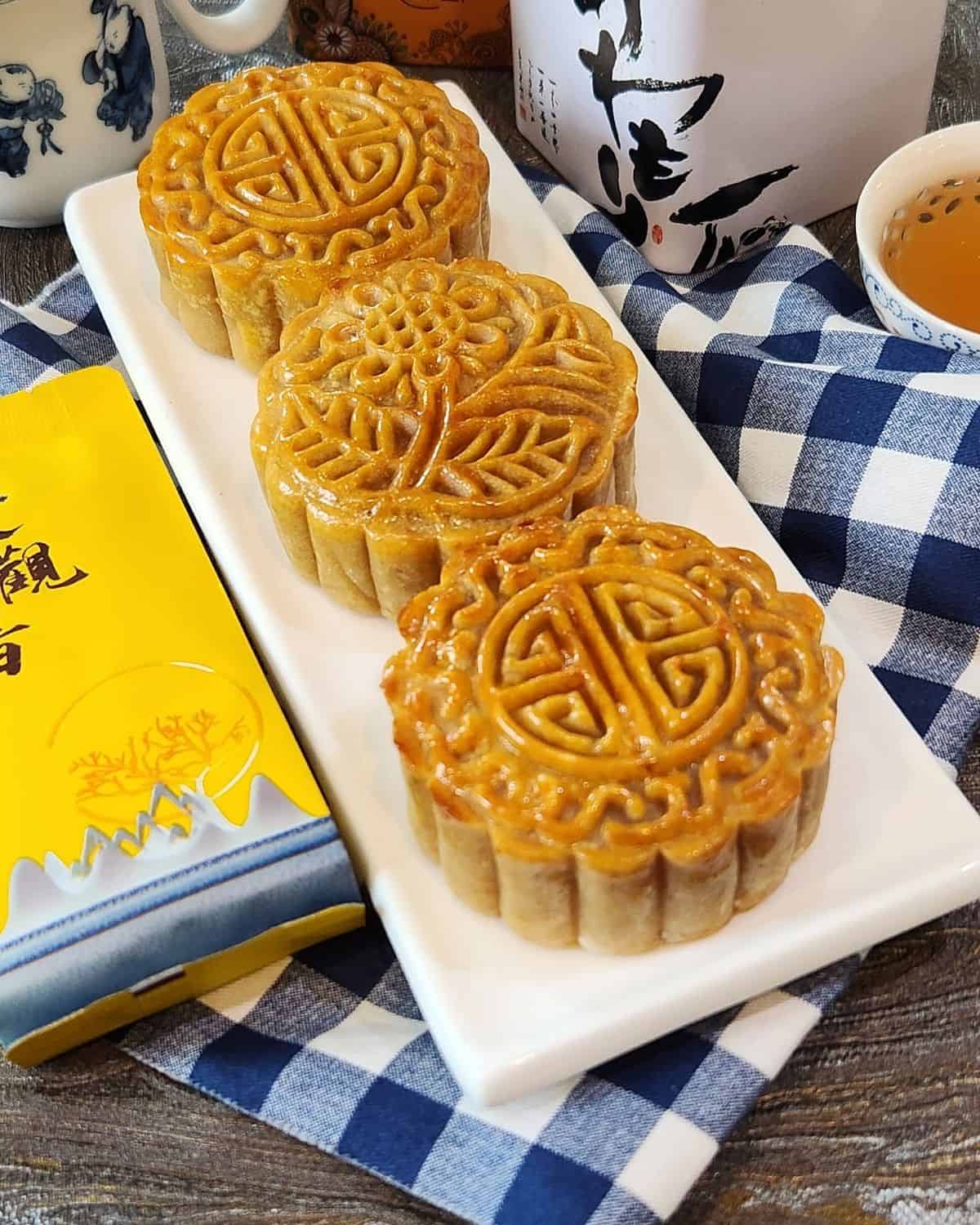
Mooncake (月饼, yue bing) is a traditional Chinese dessert enjoyed during the Mid-Autumn Festival, a celebration of harvest, family, and the full moon. A classic mooncake recipe features a thin golden crust made with fragrant golden syrup, filled with lotus seed paste and homemade salted egg yolk, a timeless favorite in Chinese pastry. You can also make salted cured egg yolks for savory toppings, which are faster to prepare as they only need five days to cure.
Over the years, traditional mooncakes have evolved from classic Hong Kong–style mooncakes to creative modern flavors, yet the joy of sharing homemade mooncakes remains a symbol of love and reunion. If you enjoy these festive treats, you’ll also love my Strawberry Snow Skin Mooncake, Wife Cake, and Salted Egg Yolk Pastry with Red Bean, other Chinese pastries that are worth trying.
Why You Will Love This Recipe
Recipe Ingredients
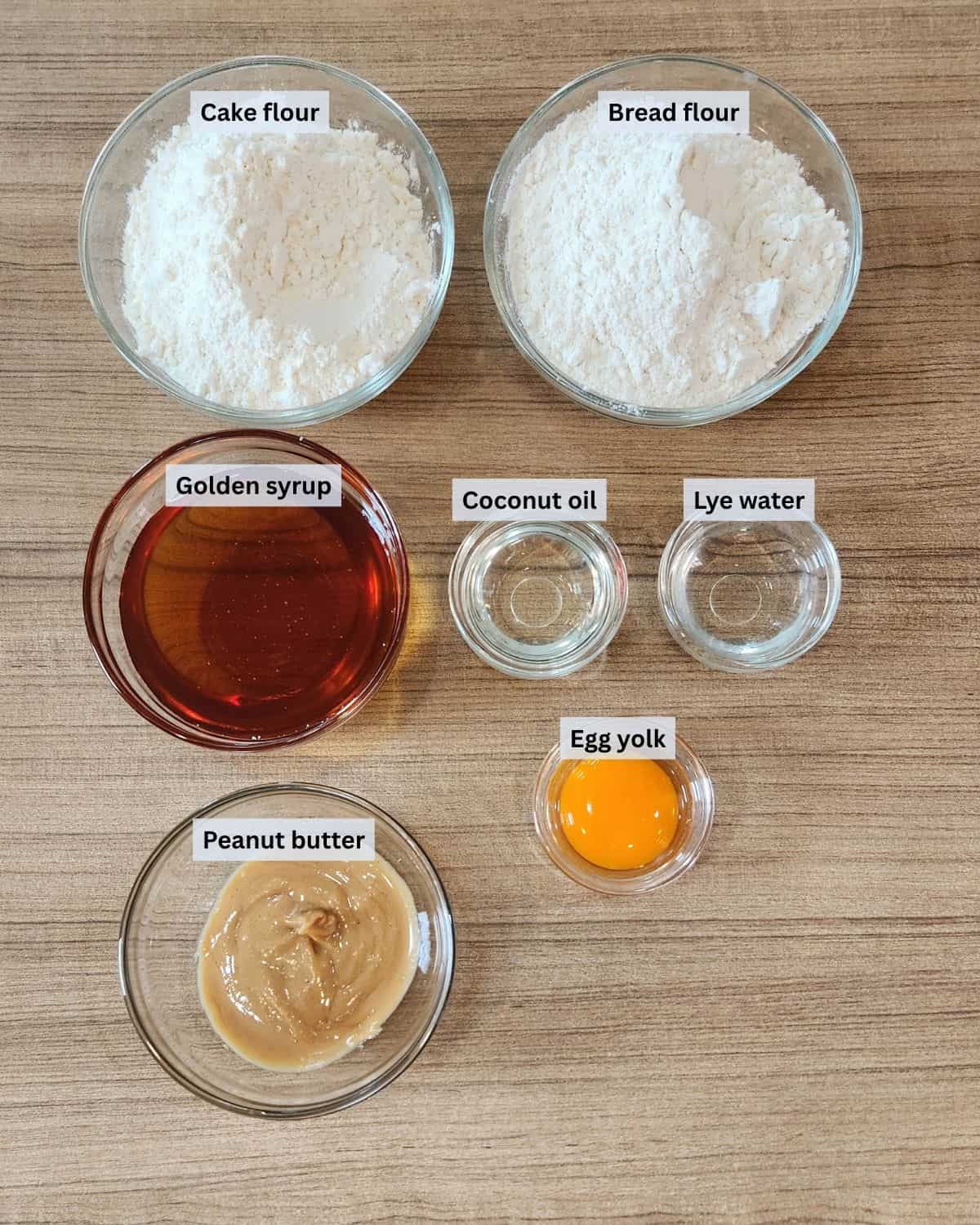
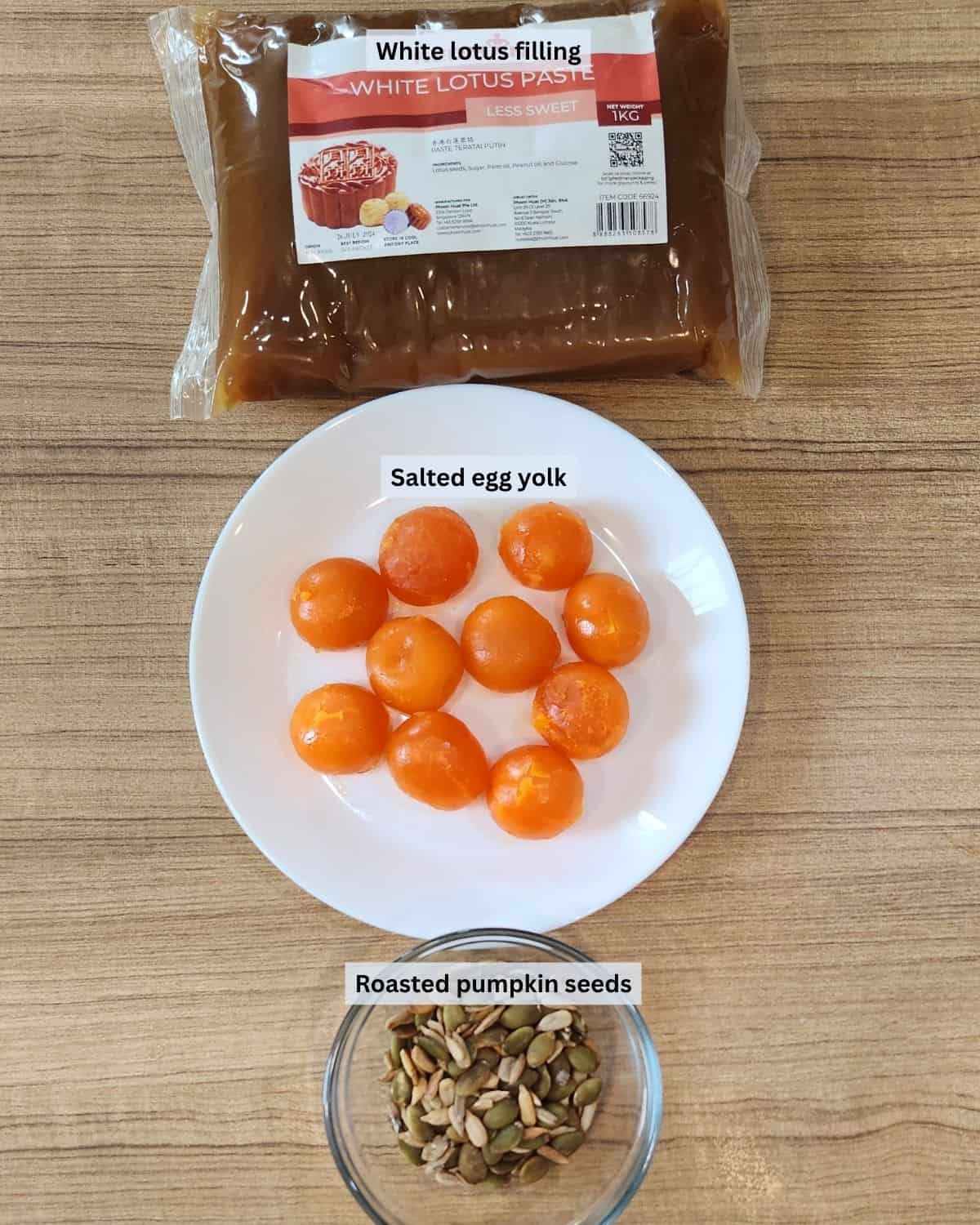
Ingredient Notes
Golden Syrup – This amber syrup, made from sugar, lemon juice, and baking soda, adds a delicate caramel aroma and helps the pastry stay moist. In Hong Kong–style mooncakes, it also prevents the crust from drying out by drawing in oil from the filling. (See my guide on how to make golden syrup at home.)
Lye Water – Also called alkaline water, this key ingredient balances the acidity of golden syrup and gives the crust its deep, golden-brown hue, the hallmark of bakery-quality mooncakes.
Peanut Butter – Just a small spoonful brings a subtle nutty fragrance and richness to the dough, rounding out the sweetness of the filling beautifully.
Cake Flour – Provides low gluten for a soft, tender pastry texture that feels melt-in-your-mouth.
Bread Flour – Combined with cake flour, this higher-protein flour adds enough strength to keep the mooncake skin pliable and moist even after several days.
Filling – Classic fillings like lotus seed paste, red bean, or mung bean paste are easy to find in Asian grocery stores before the Mid-Autumn Festival. Choose one you love or mix and match for variety!
Salted Egg Yolk – Bake the yolks for about 5 minutes before wrapping them in the filling to enhance flavor and shelf life. If you enjoy making things from scratch, try crafting your own salted egg yolks at home for that authentic touch.
Mooncake Mold – Modern molds come in different sizes and intricate patterns, often resembling ancient coins. Each mold includes a stamp and piston press for perfect shaping. Common sizes are 50 g, 75 g, and 100 g, so check the total weight before buying.
Be sure to check out the full recipe and ingredient list below
Substitutions & Variations
Flour Choices – If you don’t have both cake flour and bread flour, you can make this mooncake recipe with all-purpose flour. The texture will still be soft, though slightly less delicate than the traditional Hong Kong mooncake crust.
Golden Syrup Substitute – If golden syrup is hard to find, you can use honey or light corn syrup in a pinch. However, the flavor and shelf life may differ, so for the most authentic results, try making your own golden syrup at home.
Filling Variations – Traditional mooncakes usually feature lotus paste with salted egg yolks, but there are endless recipes for mooncakes with different flavors:
- Red bean paste (classic and widely available)
- Mung bean paste (lighter and less sweet)
- Black sesame paste (nutty and fragrant)
- Custard filling (popular in modern Hong Kong mooncakes)
- Mixed nuts and dried fruit (a traditional style called “five kernels”)
Egg-Free or Vegan – For a vegan variation, skip the salted egg yolk and use red bean, lotus seed, or black sesame filling. You can also brush the skin with a non-dairy milk wash instead of egg wash for a shiny finish.
Creative Modern Flavors – Beyond traditional mooncake recipes, some bakers experiment with matcha, taro, durian, chocolate, or even coffee paste. These give your mooncakes a unique twist while still honoring the festival.
How to Make Mooncake
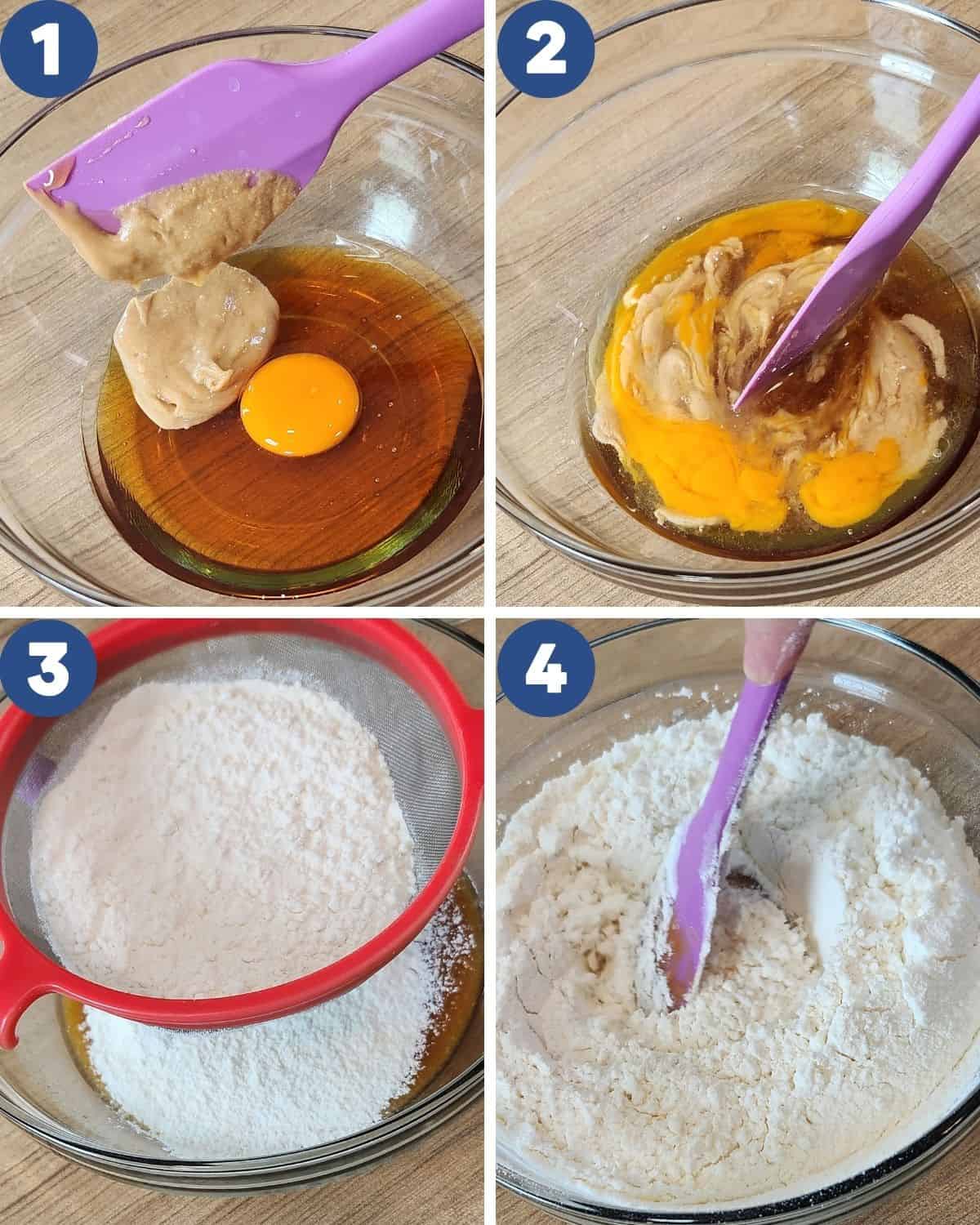
STEP 1. In a bowl, mix golden syrup, egg yolk, and peanut butter (Image 1). Stir until smooth (Image 2). Sift the flour into the bowl (Image 3) and mix again until fully incorporated (Image 4).
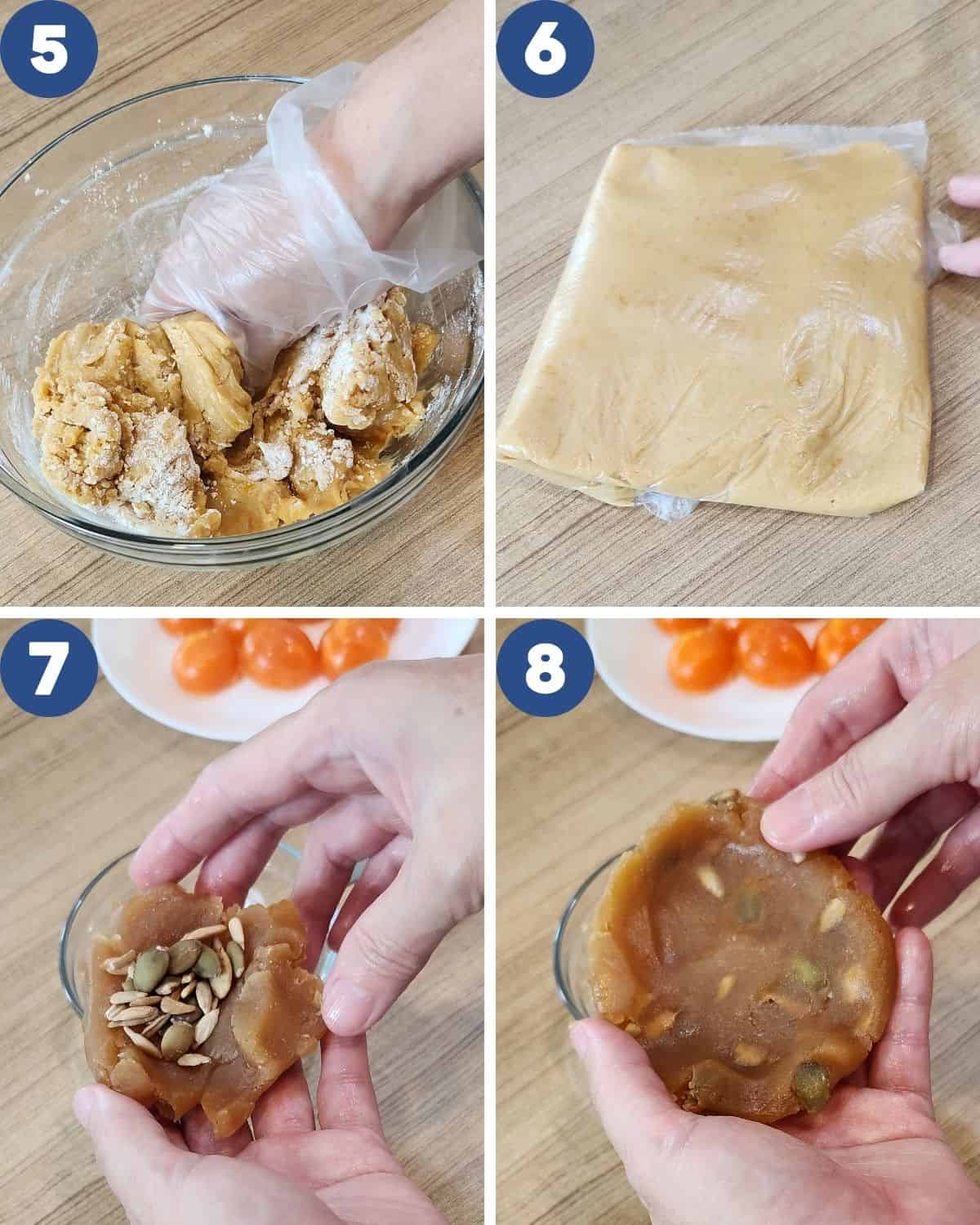
STEP 2. Knead the dough with your hands until it’s smooth and no longer sticky (Image 5). Place it in a plastic bag and let it rest for 1–2 hours (Image 6). This helps the dough relax and absorb the syrup evenly.
Lightly spray the salted egg yolks with water, then roast them at 160°C for 5 minutes to keep them moist. Mix sunflower seeds evenly into the lotus-paste filling (Image 7). Adjust the amount of filling based on your mold size — for a 100 g mold, use about 65 g of filling.
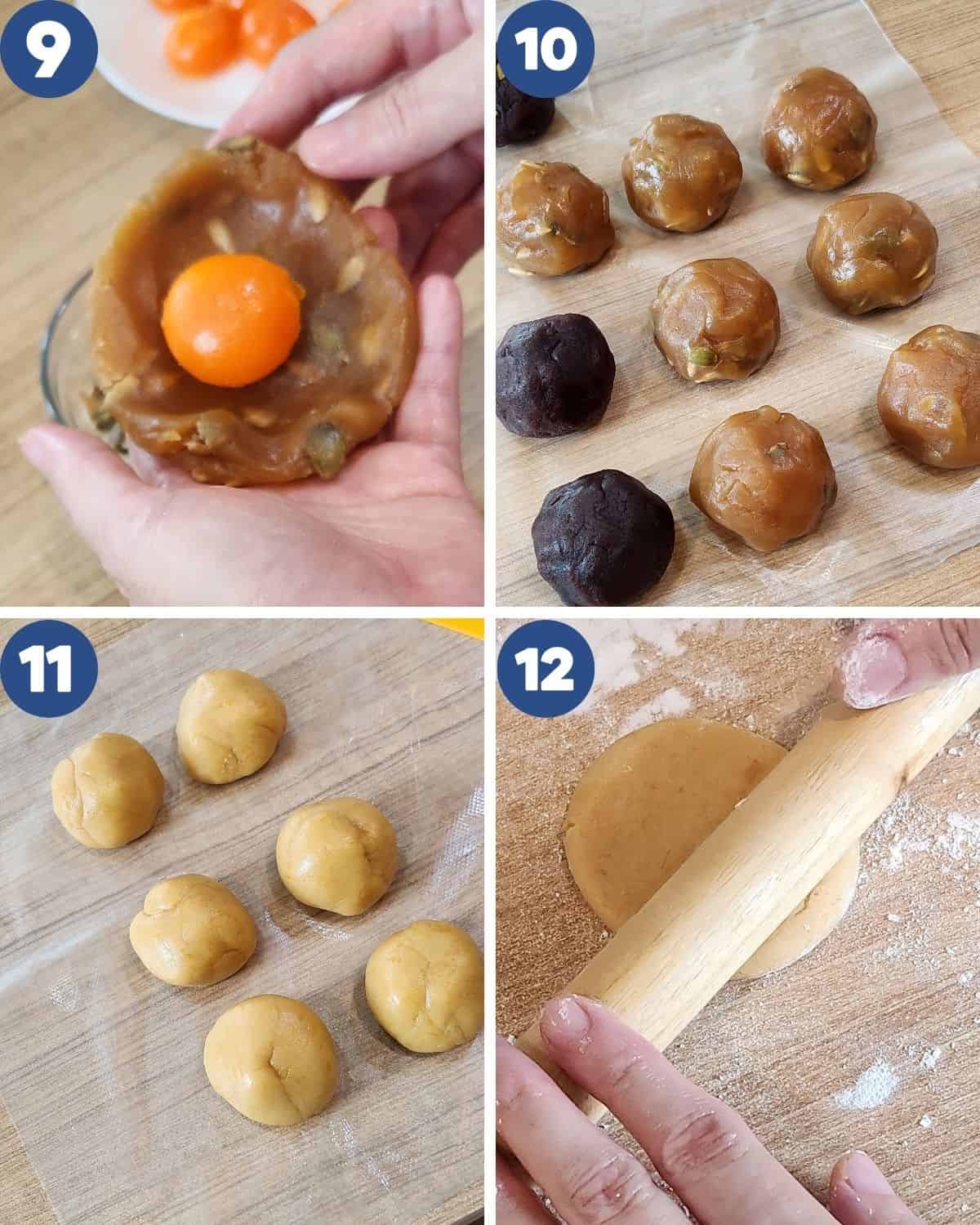
STEP 3. Wrap each roasted salted egg yolk with the prepared filling (Images 9, 10) and set aside. Weigh 35 g of dough for the outer skin (Image 11), round it, then flatten it thinly with a rolling pin (Image 12).
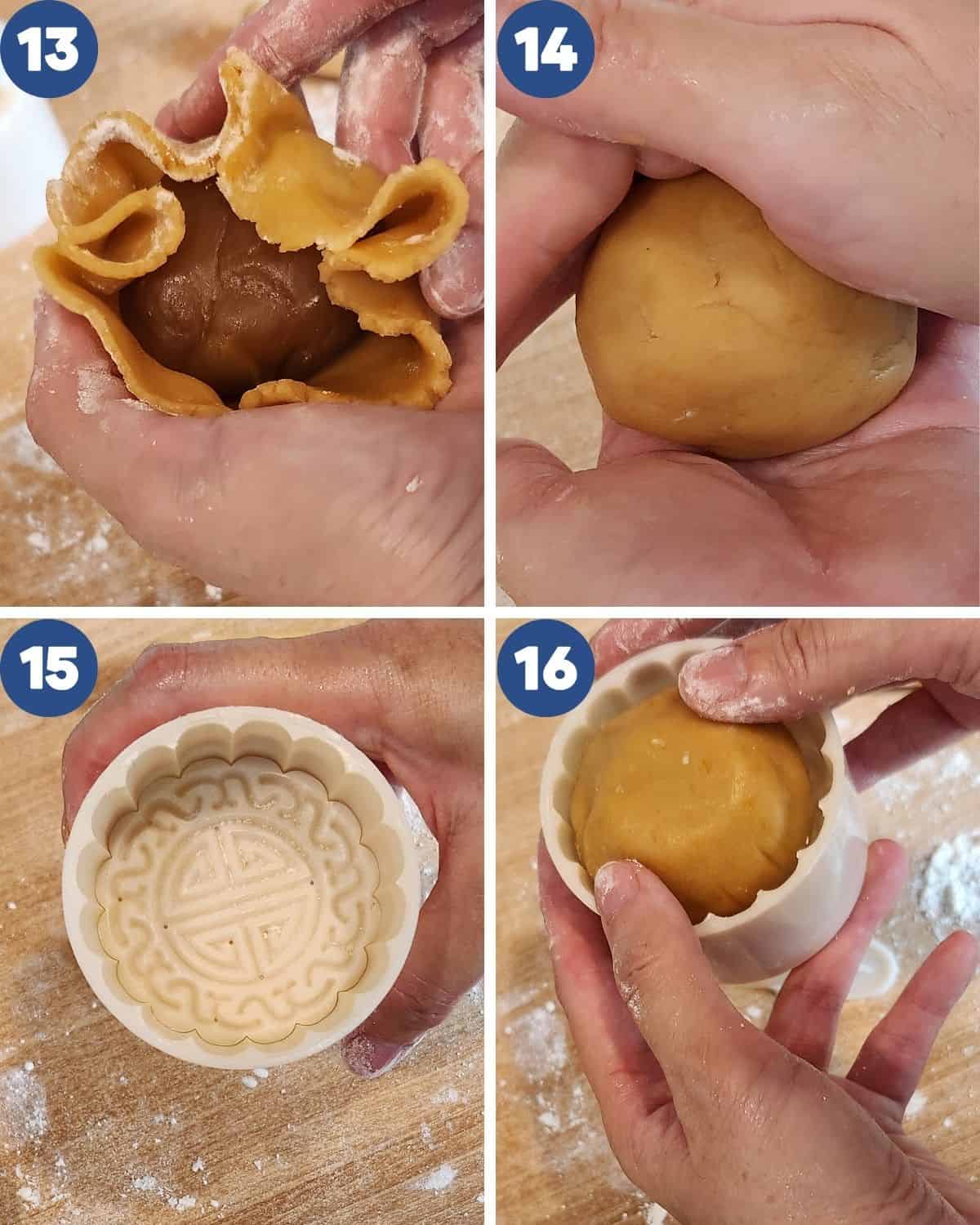
STEP 4. Place the filling in the center of the dough and wrap it gently (Images 13, 14). Smooth and round the dough ball. Lightly dust the mooncake mold with flour (Image 15), then place the dough inside (Image 16).
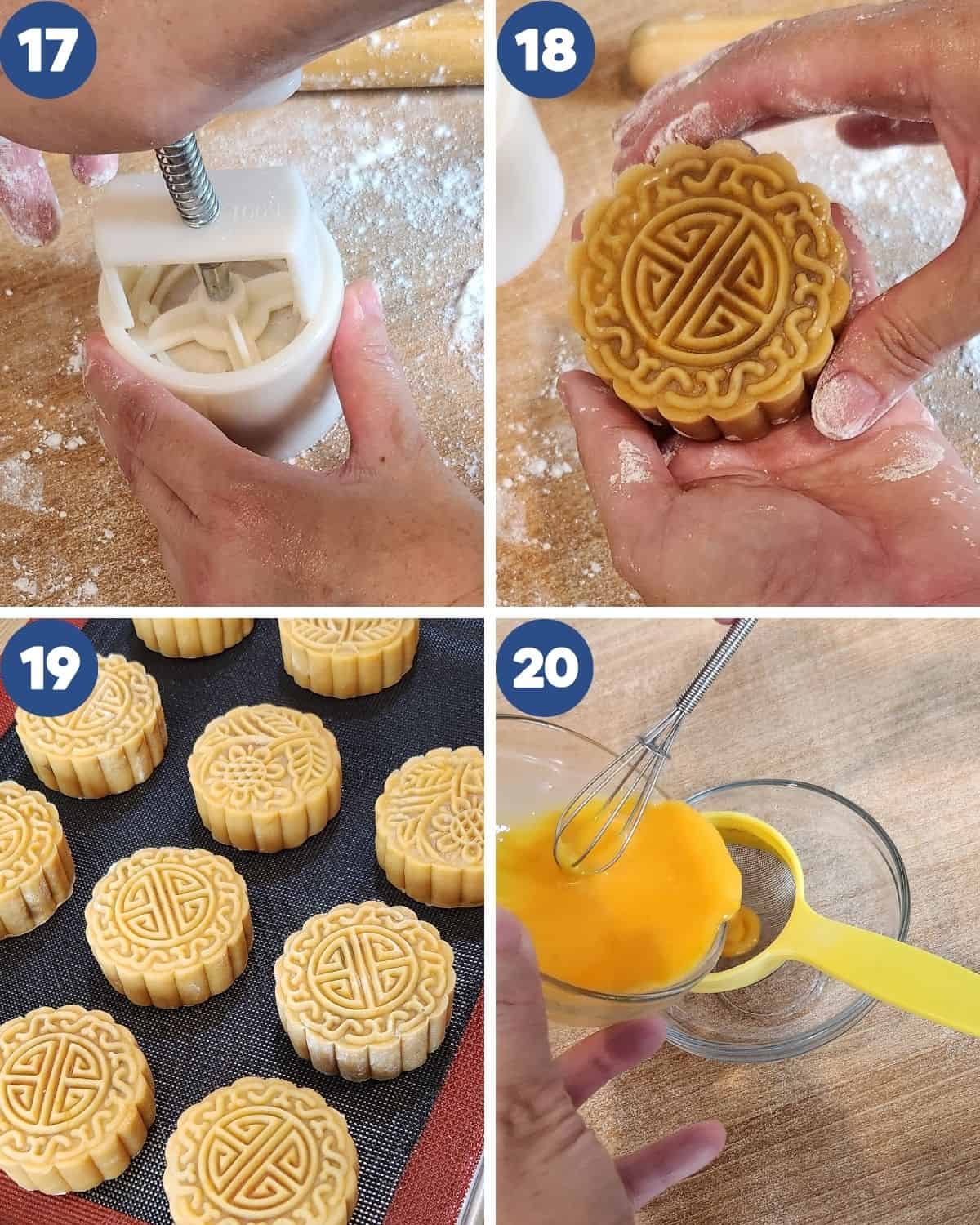
STEP 5. Press the mold firmly to imprint the pattern (Images 17, 18). Arrange the shaped mooncakes on a lined baking tray. Bake in a preheated oven at 180°C (356°F) for 8–10 minutes, until the surface looks set (Image 19). Prepare the egg wash and strain it for a silky-smooth glaze (Image 20).
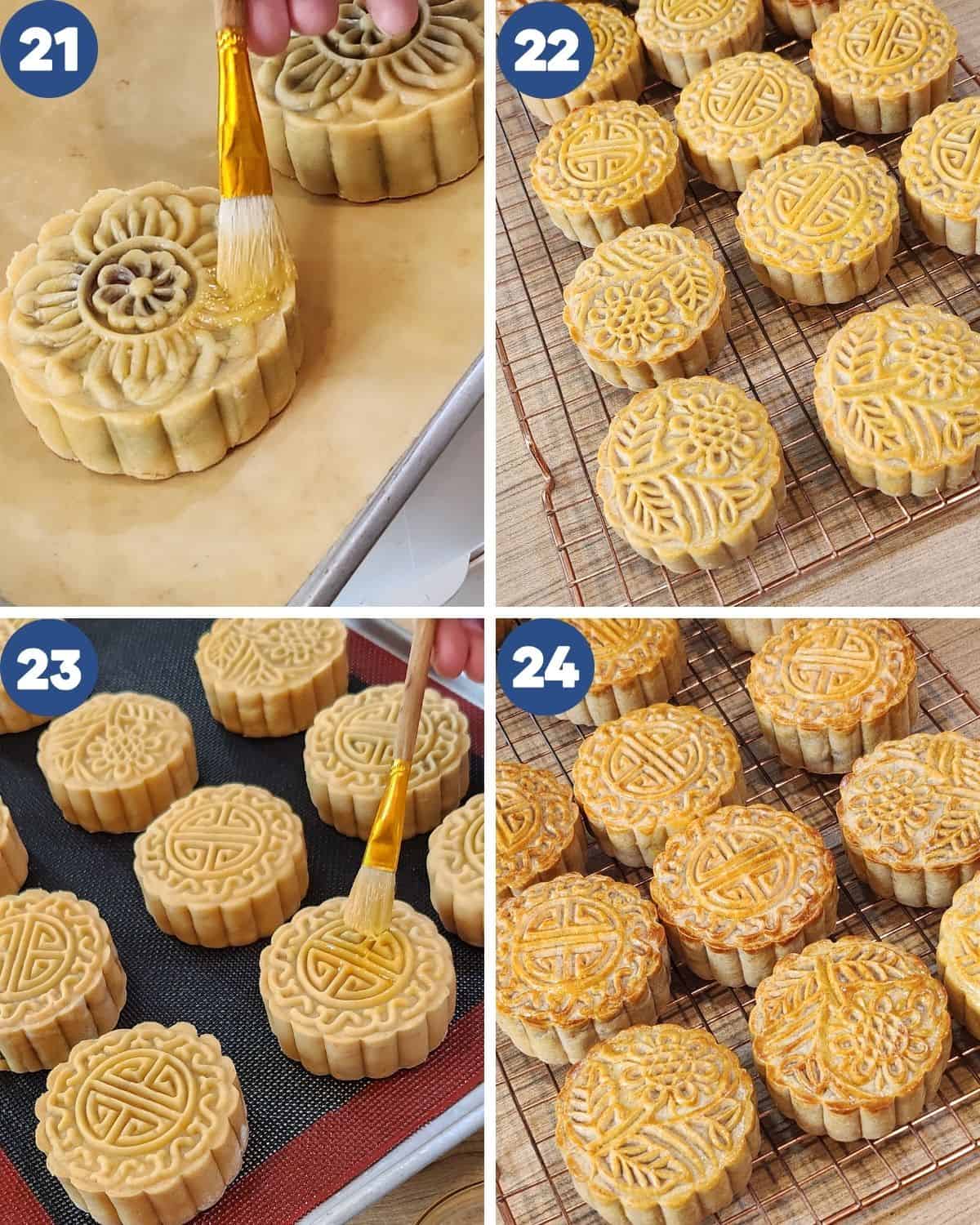
STEP 6. Brush a light, even layer of egg wash over the surface (Image 21) and bake for 5 minutes (Image 22). Repeat with another thin coat (Image 23) and bake again for 5 minutes, or until the crust turns beautifully golden brown (Image 24).
STEP 7. Transfer the mooncakes to a wire rack to cool completely. Store them in an airtight container for at least one day before serving. This resting period allows oil from the filling to migrate into the crust, making it glossy, tender, and aromatic. Enjoy your mooncakes from the second day onward for the best flavor!
Pro Tips
- Lightly dust your mold – Coat the mooncake mold with a thin layer of flour, then shake or brush off any excess. This helps the dough release smoothly after pressing, keeping the edges neat and clean.
- Don’t forget the piston – Dust the mold’s piston with flour as well, and tap off the extra. A lightly floured surface prevents sticking and keeps the pattern imprint crisp.
- Press with control – Place the rounded dough into the mold, press it down onto the baking tray, and hold for a moment to let the pattern form evenly. For the most defined result, press gently several times rather than once with full force.
- Strain the egg wash glaze – Use a fine mesh strainer to sieve the egg wash mixture. This removes bubbles and gives you a silky-smooth finish on the crust.
- Brush thinly and gently – Apply the egg wash in a light, even layer to preserve the pattern details. Avoid letting it pool in the crevices—if it does, blot gently with a kitchen towel before baking.
- Weigh your dough correctly – The skin should be about 35% of your total mold size. For a 100 g mold, that means around 35 g of dough and 65 g of filling. This ratio ensures the right balance between thin crust and generous filling.
Serving Suggestions
Mooncakes are best enjoyed after they’ve rested for a day or two, allowing the skin to soften and the flavors to meld together. Traditionally, they’re served in small wedges with a cup of hot tea to balance the richness of the filling. Pair this Hong Kong mooncake with:
- Chinese teas such as jasmine tea, oolong tea, or pu-erh tea, which cut through the sweetness and complement the nutty lotus paste.
- Homemade drinks like Rose Milk Tea, Assam Milk Tea, Lemongrass Pandan Tea for refreshing beverages.
- A festive dessert spread featuring other Chinese pastries; try my Strawberry Snow Skin Mooncake for a chilled version, or Red Bean Pastry with Egg Yolk for a flaky, savory-sweet treat.
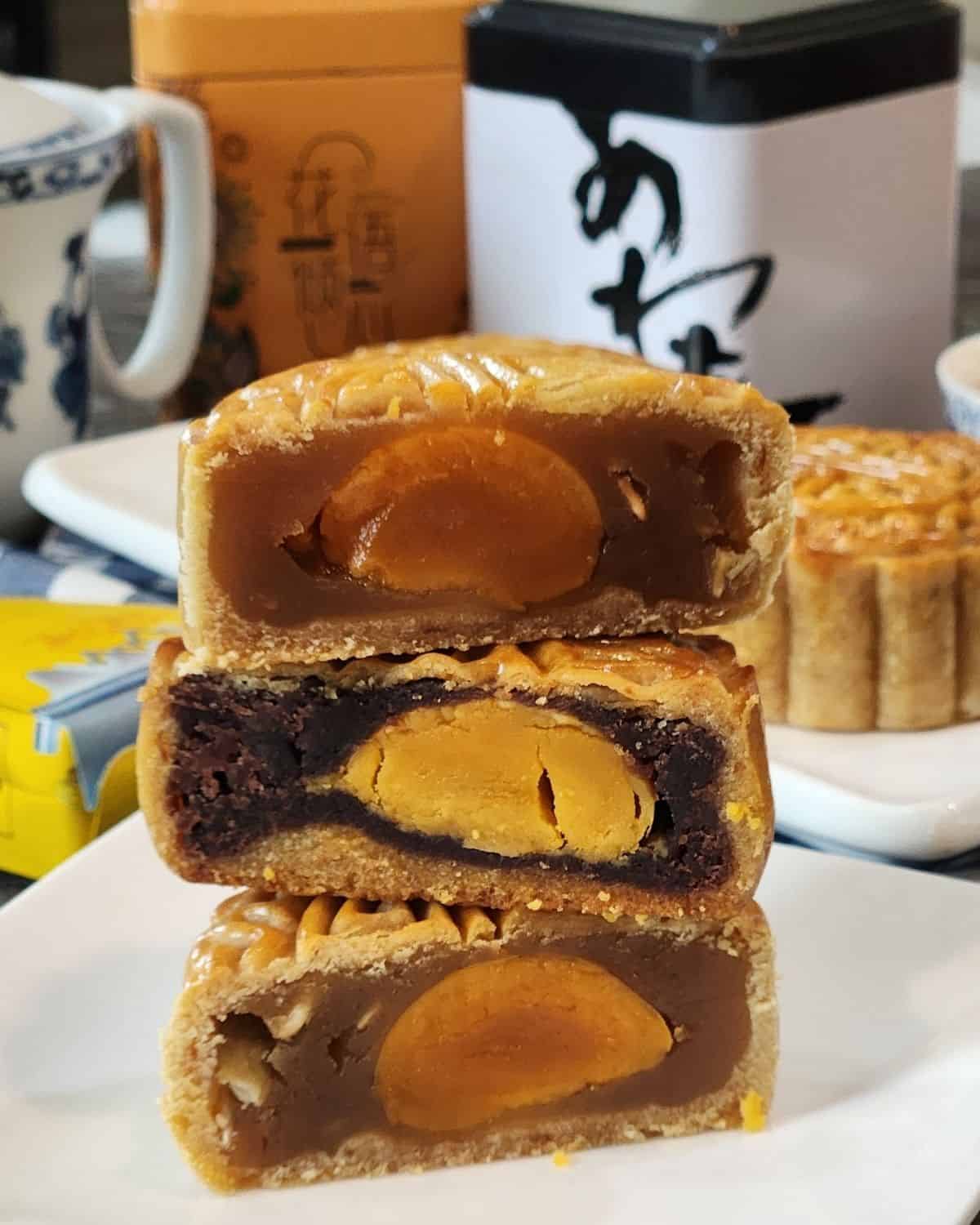
FAQs about Mooncake Recipe
Traditional mooncakes are usually filled with lotus seed paste and salted egg yolk. Other classic fillings include red bean paste, mung bean paste, and five-kernel nut filling. Hong Kong mooncakes are especially known for their glossy crust and lotus paste filling.
Yes! While salted egg yolks are a signature ingredient in many traditional mooncake recipes, you can leave them out or replace them with other fillings like red bean, black sesame, or custard.
Freshly baked mooncakes often have a dry crust. Letting them rest in an airtight container for 1–2 days allows the golden syrup and oil from the filling to soften the skin. This process, called “回油” (hui you), gives mooncakes their shiny, tender texture.
Hong Kong mooncakes are baked with a golden, glossy crust, while snow skin mooncakes are made with a soft, chewy wrapper and are eaten chilled. Both are popular Mid-Autumn Festival treats but have very different textures.
Absolutely. Use vegan fillings like lotus paste, red bean, or black sesame, skip the salted egg yolks, and replace the egg wash with plant-based milk for shine.
Storage
Resting (回油 hui you): Freshly baked mooncakes are best after resting for 1–2 days in an airtight container at room temperature. This allows the skin to absorb oil from the filling, becoming soft and shiny.
Room Temperature: Traditional mooncakes (without dairy-based fillings) can be stored in an airtight container at room temperature for up to 7–10 days.
Refrigeration: If your mooncakes contain salted egg yolks, custard, or other perishable fillings, store them in the fridge. They will last for about 5–7 days. Bring to room temperature before serving for the best texture.
Freezing: To keep mooncakes longer, wrap each one tightly in plastic wrap and place them in an airtight container. Frozen mooncakes can last up to 1–2 months. Thaw at room temperature for a few hours before enjoying.

Traditional Mooncake
Equipment
- 1 mooncake mold 100 gr
Ingredients
Pastry Skin
- 130 gr cake flour
- 130 gr bread flour
- 160 gr golden syrup
- 12 gr lye water
- 30 gr coconut oil
- 1 egg yolk
- 25 gr creamy peanut butter
Filling
- White lotus paste
- Salted egg yolk
Egg Wash
- 2 egg yolk
- ½ egg white +- 20 gr
Instructions
- In a bowl, mix golden syrup, egg yolk, and peanut butter. Stir until smooth. Sift the flour into the bowl and mix again until fully incorporated.
- Knead the dough with your hands until it’s smooth and no longer sticky. Place it in a plastic bag and let it rest for 1–2 hours. This helps the dough relax and absorb the syrup evenly.
- Lightly spray the salted egg yolks with water, then roast them at 160°C for 5 minutes to keep them moist. Mix sunflower seeds evenly into the lotus-paste filling. Adjust the amount of filling based on your mold size — for a 100 g mold, use about 65 g of filling.
- Wrap each roasted salted egg yolk with the prepared filling and set aside. Weigh 35 g of dough for the outer skin, round it, then flatten it thinly with a rolling pin.
- Place the filling in the center of the dough and wrap it gently. Smooth and round the dough ball. Lightly dust the mooncake mold with flour, then place the dough inside.
- Press the mold firmly to imprint the pattern. Arrange the shaped mooncakes on a lined baking tray. Bake in a preheated oven at 180°C (356°F) for 8–10 minutes, until the surface looks set. Prepare the egg wash and strain it for a silky-smooth glaze.
- Brush a light, even layer of egg wash over the surface and bake for 5 minutes. Repeat with another thin coat and bake again for 5 minutes, or until the crust turns beautifully golden brown.
- Transfer the mooncakes to a wire rack to cool completely. Store them in an airtight container for at least one day before serving. This resting period allows oil from the filling to migrate into the crust, making it glossy, tender, and aromatic. Enjoy your mooncakes from the second day onward for the best flavor!
Video
Notes
- Lightly dust your mold – Coat the mooncake mold with a thin layer of flour, then shake or brush off any excess. This helps the dough release smoothly after pressing, keeping the edges neat and clean.
- Don’t forget the piston – Dust the mold’s piston with flour as well, and tap off the extra. A lightly floured surface prevents sticking and keeps the pattern imprint crisp.
- Press with control – Place the rounded dough into the mold, press it down onto the baking tray, and hold for a moment to let the pattern form evenly. For the most defined result, press gently several times rather than once with full force.
- Strain the egg wash glaze – Use a fine mesh strainer to sieve the egg wash mixture. This removes bubbles and gives you a silky-smooth finish on the crust.
- Brush thinly and gently – Apply the egg wash in a light, even layer to preserve the pattern details. Avoid letting it pool in the crevices—if it does, blot gently with a kitchen towel before baking.
- Weigh your dough correctly – The skin should be about 35% of your total mold size. For a 100 g mold, that means around 35 g of dough and 65 g of filling. This ratio ensures the right balance between thin crust and generous filling.

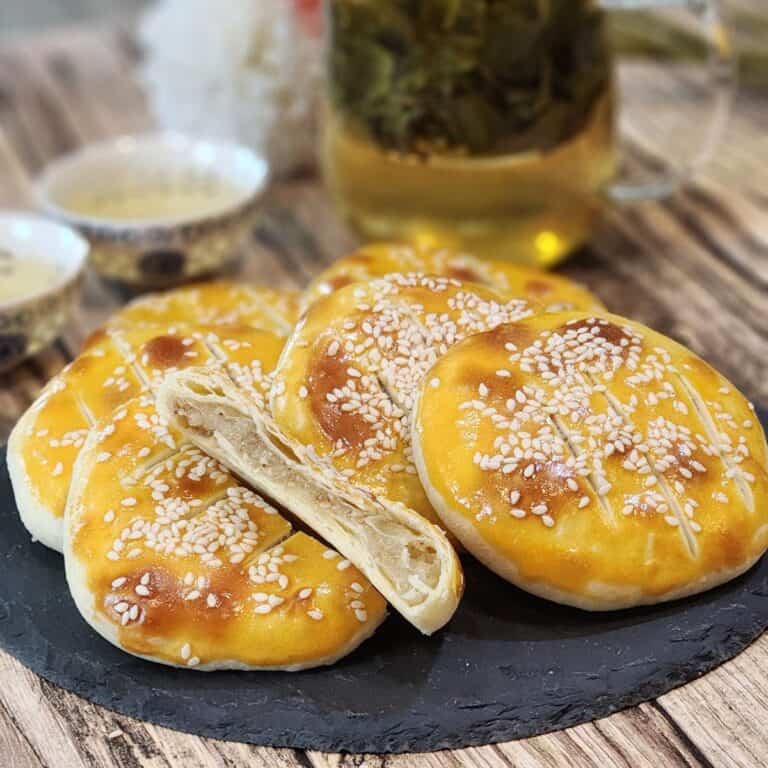


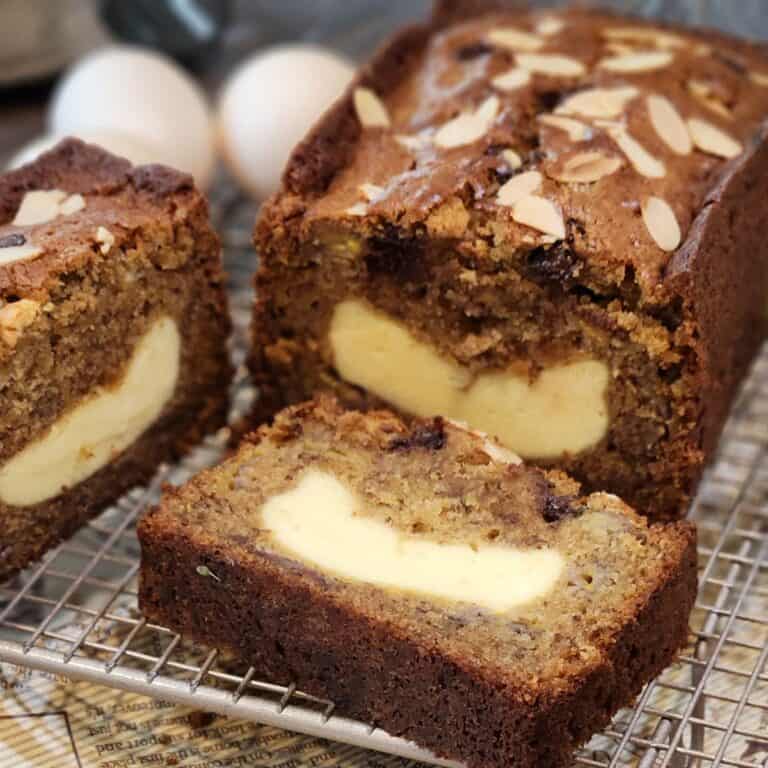
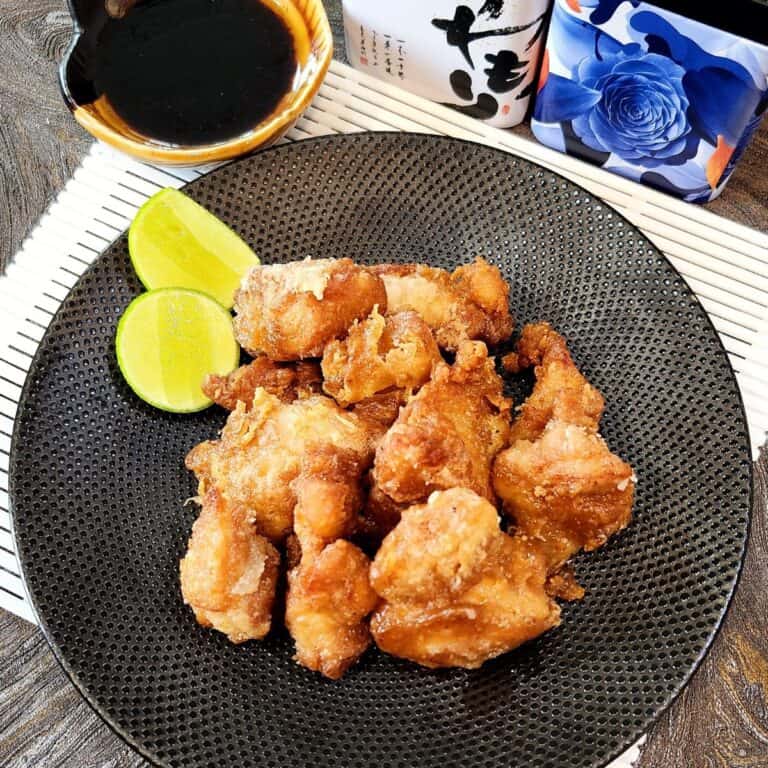


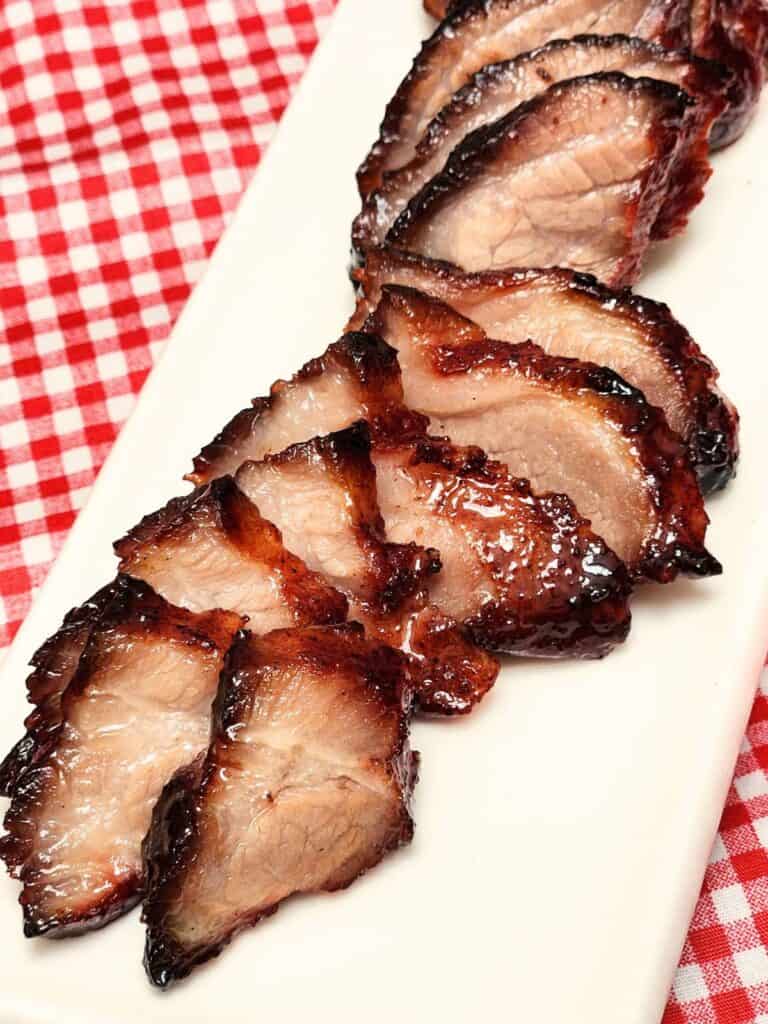

Every year, I will use this recipe to make mooncakes for my family. I even make more to give to relatives and friends. The sweetness is perfect with nutty caramel flavor. It is so easy to make!